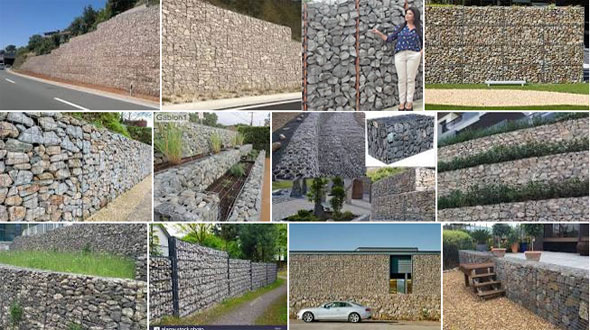Gabion Wall Construction
- Concrete Cost Estimator
- Concrete Continuous Footing
- Landscape Bidding and Estimating
- Construction Cost Estimating
- Concrete and steel cost estimation
- Construction Cost Estimate Breakdown
- Construction Estimating Worksheet
- Home Construction Cost Estimate
- Estimate Pricing Sheet
- Sheet for General Contractor
- Construction Cost Estimate
- Labor Materials Cost Estimator
- Masonry Estimating Sheet
- Sheet for Building Contractor
- Construction Schedule Bar chart
- General Cost Estimator Sheet
- General Construction Estimate
- Building and Road Estimating Sheet
- Detailed expense estimates
- Door and Window Takeoff Sheet
- General Construction Cost Estimating Sheet

Gabion walls refer to the structures that are noticeably flexible, sustainable, inexpensive, absorbent, aesthetically appealing. It is built as stepped front face or smoothed front face.
The gabion walls are used for benches, fencing, pond surrounds, and even stair rails.
In gabion walls, lots of cages are used and they are filled with rocks and other construction elements and set up to build the gabion wall.
Steel wire baskets (cages) are formed in factory by 90x90x90 cm steel wire panel sides and the mesh size remains 7.62 x 7.62 cm. It is unfurled at the and various panel are compiled to develop the basket.
They are manufactured with meshes Triple twisted and squared type 8x10 cm meshes of steel wire (with low carbon content) of 2.7 mm are used in gabion walls, which provide three layers of galvanized, with 270 grams of zinc. The edges of the gabions are also reinforced with 3.4 mm wire. Wire for the clamping of the 2.2 mm pieces is also utilized.
The gabions are normally available in the shape of boxes with lengths of 1.5, 2, 3 and 4 meters, width of 1 meter and a height of 0.5 or 1.0 meters.
The longevity of gabions is mainly based on the lifespan of the wire and the amount of salt spray it is exposed to.. The structure will collapse if the wire fails. Though galvanized steel wire is mostly used, but PVC-coated and stainless steel wire are also applied. PVC-coated galvanized gabions can last for 60 years.
Gabion walls are extremely permeable and they can deviate any hydrostatic pressure, eliminating the need to arrange a drainage system.
Materials Used For Filling: The longevity of the wall is mainly depend on the proper selection of rocks or stones. The design of gabion is created on the basis of the mass of filler materials and the following factors should be taken into consideration while choosing the filler :
Also Read: Commonly used retaining walls and their functionalities
Grading of fill: it is very much crucial since it can minimize the small voids and accordingly resist settlement. Gabion graded fill among 100 mm to 200 mm can be utilized normally with minimal 6 percent smaller or larger diameter.
Fill angularity: It can strengthen interlocking and reduces face deformation of the wall.
Rounded filler (rounded stone): It comprises lesser interlocking in respect of angular rocks. So, it is recommended to utilize a stronger mesh to recover that.
Design of Gabion Wall: The design process of gabion wall is similar to gravity retaining wall. Units of gabion wall are regarded as one cohesive mass for design purposes.
The major forces found on the wall are lateral earth pressure at the back face and vertical forces which is the weight of the wall. The purpose of the latter force is to withstand the former one.
Besides, if other types of loads similar to seismic are encountered, they should be considered in the analysis.
Both stepped face and smoothed face gabion wall are designed on the basis of equivalent principle.
Vertical load (Weight of unit length (1m)) = wall cross section x gabion fill density.

- Application of concrete calculator
- Roofing Calculator can streamline the roof estimating process
- House construction cost calculator
- Engineering column design excel spreadsheet
- Material Estimating Sheet with Excel
- Materials List and Cost Estimate Worksheet
- Concrete Slab Estimating Calculator Sheet
- Common types of foundations for buildings
- Online calculation of construction materials
- Estimating with Excel for the Small Contractor
- Concrete Beam Design Spreadsheet
- Virtual Construction Management app for construction
- Autodesk’s Project Skyscraper
- Reed Construction’s Reed Insight
- Manage your construction project documentation
- Costimator, the popular cost estimating software
- On Center Software for construction professionals
- Free Construction Estimating Software
- Plumbing Calc Pro
- Cost Estimate Worksheet
- HVAC Piping Quantity Takeoff Worksheet
- Construction Estimating Software Sheet
- Estimate Cost Templates
- Construction Punch List
- Construction cost estimating template consisting estimating basic
- Gantt Chart Template for Excel
- Download Civil Engineering Spreadsheets with Verification
- The Building Advisor Estimating and Budgeting Worksheet
- Spreadsheet for design of concrete bridge
- Construction Estimating Software Free








